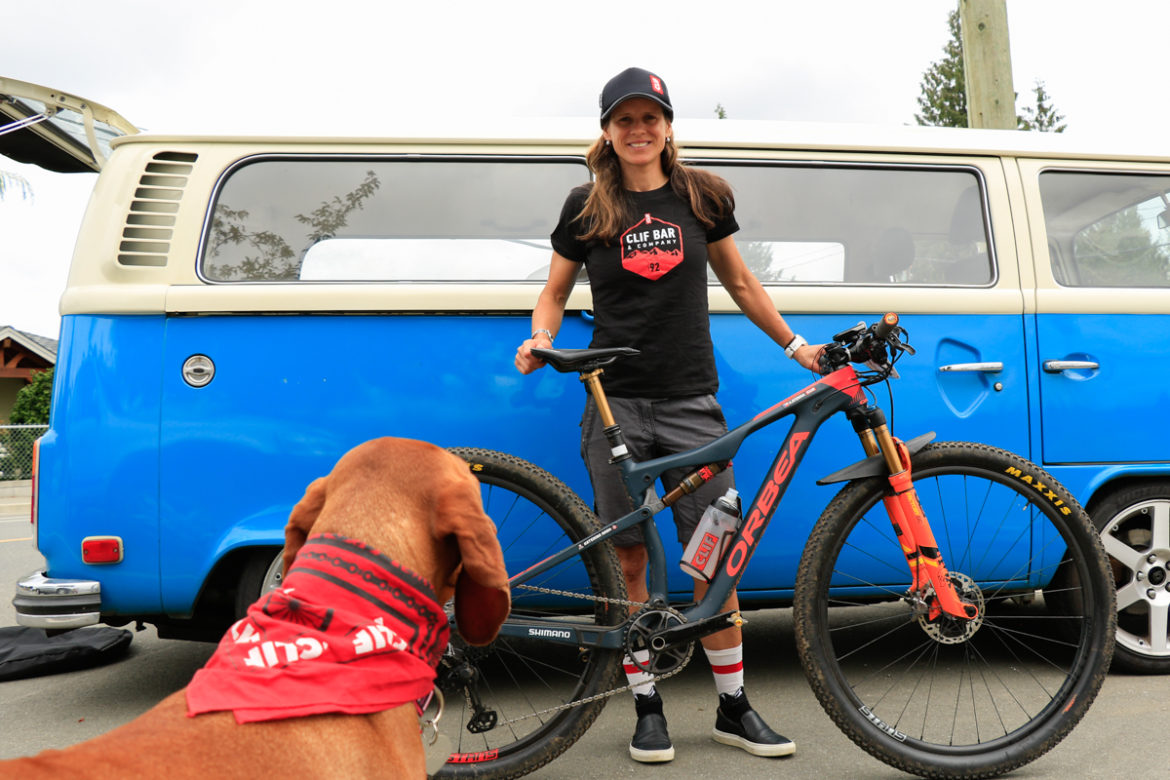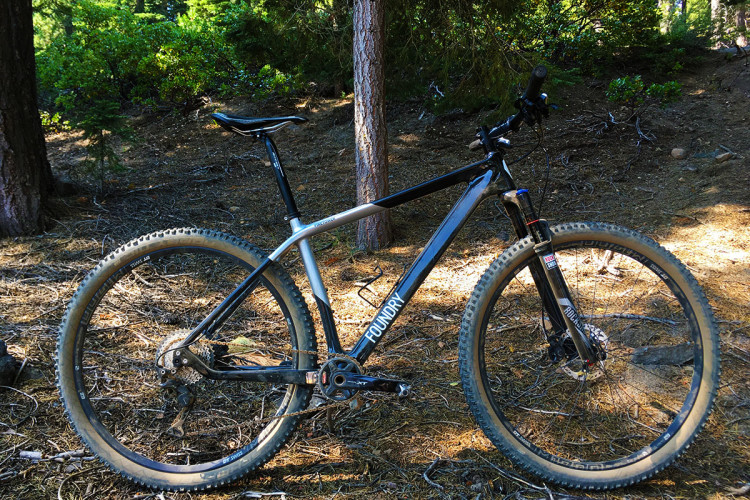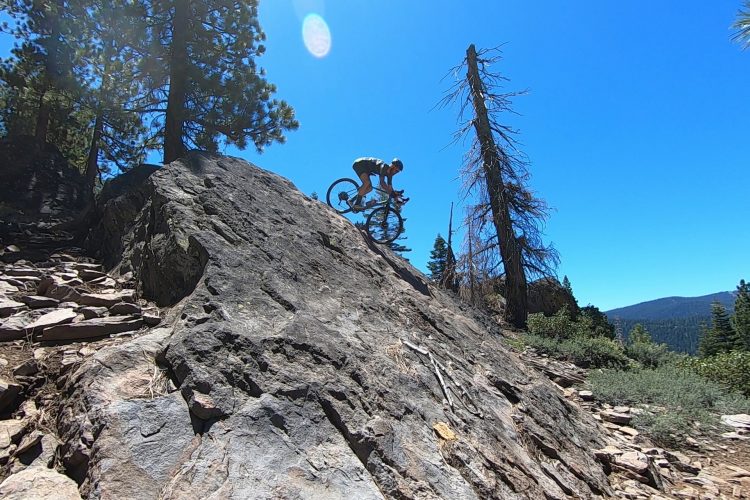
It’s safe to say that most of us can get through one, long, difficult ride on a given day to test our endurance, with the proper amount of snacks and determination. Many of us have tested our endurance whether it’s a 15-mile ride at elevation or a 25-mile XC race. At the end of the day, you can pound a few beers, dig into that giant bowl of chicken fettuccine, and sleep in the next day.
Stage racing is a drastically different approach to endurance though. Depending on the race, that energy expenditure stays high day after day. In a lot of stage races, the strength it takes to complete the downhills is just as much as the endurance to summit the climbs. Then, there’s the aspect of learning the field around you, and recognizing the racers that you will be riding next to for several days.
This year, Katerina Nash, who races for the Clif Bar Pro Team, won the women’s category of the seven-day BC Bike Race by more than half an hour. Nash has been racing professionally for over two decades, and at 42-years-young, is still one of the top racers to beat on the trail. She carries a hefty cross-country race schedule over the summer, followed by cyclocross in the fall. We caught up with the five-time Olympian to pick her brain about stage racing.
You raced a particularly gnarly EWS this year close to home at Northstar. What was it like and how was it different from your usual XC races?
It was very different from my usual racing. To start, the bike was way different and I didn’t have that much time to ride it. Luckily the Fox crew helped me dial in my suspension and I was feeling pretty good on the bike once I learned about low and high speed rebounds… haha. I live 15 minutes from Northstar and so the idea was to give it a try and see what EWS [racing] is all about. It was challenging, but I felt really good completing it. It was very different kind of race and it was great to learn some new things and [a new] style of riding. I was so impressed with the enduro racers. Their speed and ability to read the trail on the go was amazing.
First off, what does your training program look like leading into a stage race? How is it different than if you were training for a one-day XC race?
I try to fit in few more longer rides and make sure I’m ready for the several days’ effort. I’m always racing way too much, so once racing gets going early spring it’s hard to fit in whole lot of training but I feel good about doing back-to-back, two to three longer rides before the stage race to get my body used to longer days on the bike. When I focused on one day XC [races], I did more interval sessions than I do these days with longer style of racing.
What does your winter training program look like when you’re not on the bike as much?

I race cyclocross, so most of my winter is spent on a bike again. After the World Champs I typically jump on XC and backcountry skis and spend the entire February on snow before returning to biking in March. For me, it’s important to change things up and do other stuff. I run and hike all year long and as a former ski racer I enjoy time on the snow. XC skiing is also important for my overall body fitness. I’m not a gym kind of person so I need to take care of my strength by doing other sports. I don’t take much time off from exercise during the off season. I just change up the activity.
Say you have a five day stage race. Is it wiser to go hard in the first few days to build a lead, or are you saving some for later? How do you decide how much to physically expend day to day?
I think stage racing is all about consistency. I’m lucky to have raced a few stage races by now and I have that experience to rely on. I try to go pretty hard every day but I’m careful about the effort knowing what is coming up next. The body is amazing and does recover well and it’s more our minds that question the day-to-day effort. I definitely race with a certain amount of caution and keep reminding myself that winning the hole shot to the singletrack isn’t as important as winning the whole race. I also try take care of my equipment during a stage race and ride with a multiple day race in mind meaning that I don’t take such a big risk I as I would in XC where you can come by the pits and get a new wheel or help from a mechanic.
How important is your nutrition during a stage race, and what does diet look like during each race day and in between?
I focus a lot on drinking. I’m pretty bad when it comes to eating and I have to force myself to eat. Drinking a lot of calories is much easier and it helps me to recover from day to day. I’ve played around with all sort of Clif Bar snacks over the years. This year I really enjoyed the Clif Bar Blocks. You can eat a smaller portion and not have to deal with the whole gel. I also added Clif Bar Cubes. They are very soft, easy to chew, [and have] a great taste. I tend to race with a CamelBak to make sure I have enough Clif Electrolyte drink. The CamelBak Chase vest is a great and lightweight pack to use for races like BCBR.
How do you typically manage passing in a stage race, which can be very tight?
Passing is a fun thing for me, because where I ride in BCBR I’m typically surrounded by lot of men. As the week goes on you learn who is a good climber and who can descend. For me, it’s mainly dealing with some egos and earning respect. Most men assume I suck at descending and want to get in front of me. Little by little I earn their respect and by the end of the week we all respect our strengths and weaknesses and don’t chop each other on the trail. It’s really fun to hear compliments from these dudes about my descending abilities at the end of the race.
What are some other stage racing strategies you have incorporated in the past?

I try to prep my bike right after the stage. With BCBR there is a bike wash at the end of each stage and I go straight there and get my bike cleaned and I check it over so I don’t have to deal with it later that day and get a nice rest instead. Also eating right after and hydrating for the rest of the day is very important!
What do you think the most important training or preparation aspect is for first-time stage racers?
Do longer rides and challenge yourself technically. Before arriving at the race I think it’s good to ride longer than usual and try to do back-to-back rides to build the endurance and confidence that you can do it. Finding riding partners who are better technically and challenging yourself during a few rides is also crucial. Finally, having all your equipment in great shape at the beginning of the race and having a plan for spare tires, hangers, a comfortable pack to ride with, and good race food that you can eat for a week.
Key takeaways for stage racing
- Focus on longer, back-to-back rides in the weeks before a stage race to build the proper endurance.
- Find training partners that are better riders than you are, to progress before the race.
- Try to be consistent day after day, rather than going all out on a single day.
- Manage your risk and equipment properly to avoid replacing multiple parts over a few days of racing. Pack extra components like derailleur hangers or tires when you travel to the race.
- Take care of your bike after every race, so you’re not rushing to fix something the morning of.
- Think about easily-digestible food for racing. Liquids and gels are easier to consume than bars.
- Try to learn the field around you quickly, so that you know where you fit in on climbs and descents.
- Following these techniques will build confidence that you can finish a stage race.




















0 Comments